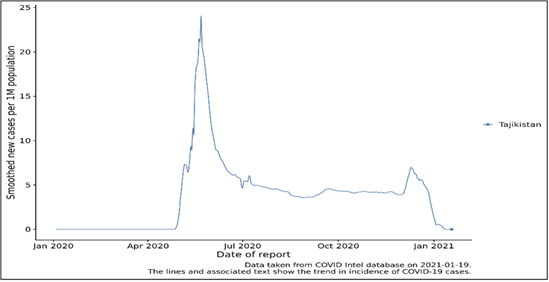After officially announcing the first 15 cases of COVID-19 on April 30, 2020, daily confirmed cases in Tajikistan rose to 200 daily cases by May. COVID-19 transmission in Tajikistan continued during the course of 2020, but during this period, WHO intervened with a range of support measures, including Emergency Medical Teams, deployment of WHO and GOARN epidemiologists, and through the provision of laboratory support in the form of WHO and international experts, and through the deployment of rapid response mobile laboratories.
One of the most important and transformative interventions was the rapid scaling-up and strengthening of national laboratory capacity for COVID-19 testing in Tajikistan. This study describes the actions taken by the Government of Tajikistan and the technical assistance provided by WHO at different stages of the pandemic to realize this achievement.
Proactive strengthening of pandemic preparedness: Measures were readied to tackle the COVID-19 pandemic before the first cases were detected on 30 April 2020. WHO supported the development of the Prime Ministers COVID-19 Operational plan which was launched in March 2020, as well as the COVID-19 Country Preparedness and Response Plan (CPRP) drafted by the Ministry of Health and Social Protection of the Population (MoHSP). Support by WHO included technical support to all administrative levels of government, supporting training to build the capacity of frontline health workers for pandemic preparedness and response, quality assurance and procurement of medical supplies to meet critical needs for life-saving medicines, personal protective equipment (PPE), COVID-19 testing kits, and development of risk communication strategies.
The WHO Regional Office for Europe Better Labs for Better Health initiative (Better Labs) was of strategic significance to strengthening preparedness in Tajikistan. Launched in 2012, Better Labs aims to support countries capacities to detect infectious diseases in WHO Member states in Eastern Europe and Central Asia. Since 2016 three major laboratories in Tajikistan have been undergoing training and mentoring for quality management implementation based on international ISO standards and WHO’s Laboratory Quality Stepwise Implementation tool and indicators. The national mentors trained through Better Labs have been building the capacity of health workers at the regional level for laboratory quality management. The commitment of the Government of Tajikistan to Better Labs meant that Tajikistan could readily deploy needed expertise to align the national testing strategy with well-planned surveillance and contact tracing strategy.
Ensuring a rapid pandemic response through strengthened laboratory capacity
Immediately after the first cases of COVID-19 were officially announced, pandemic response activities were set in motion by the Incident Management Support Team (IMST) of the WHO European Regional Office in early May 2020, at the request of the Tajikistan government. Working with national stakeholders, the deployment of the IMST gave rise to an active body of work that covered the following areas: formation of a national laboratory working group, conducting a laboratory situational analysis for COVID-19 response that included short-, mid and long- term recommendations, drafting of a national action plan for the laboratory response to COVID-19, and coordination of all partners during the implementation of the action plan.
Three main strategies were implemented to rapidly scale up national laboratory testing capacity, which was identified as a critical need during the situation analysis:
- Ten regional-level laboratories were identified, upgraded, and activated to conduct COVID-19 testing. These sites are the SES laboratories in Bokhtar and Kulob, in Dangara Hospital, Blood Center in Bokhtat (Khatlon region),SES laboratories in Rasht, in Tursunzoda (DRS), in Medical Complex Istiklol, City SES laboratory (Dushanbe), SES laboratory in Khorog (GBAO) and SES laboratories in Khujand, Panjakent (Sughd Region). This was in addition to major upgrades to the national-level laboratories (National Public Health laboratory, Virology laboratory at the National SES, National Reference Laboratory and Tajik Research Institute of Preventive Medicine) that were already conducting COVID-19 testing.
- Emergency Medical Teams and Rapid Response Mobile Laboratories were deployed with financial support from WHO Regional Office Europe, under the framework of WHO’s Global Outbreak Alert and Response Network (GOARN). GOARN laboratory experts also provided technical support to 8 laboratories (5 in Dushanbe, 1 Dushanbe city, and 2 regional laboratories) for quality assurance and improved workflow settings.
- Nation-wide capacity building of all front-line workers on pandemic response, including on COVID-19 testing protocols and procedures. The capacity-building trainings drew from the country’s pool of domestic expert trainers whose capacity had been strengthened through the Better Labs initiative. Following an initial WHO-supported training-of-trainers (ToT) training, domestic experts conducted cascade trainings and provided supportive supervision to health workers at national and regional levels. Training modules developed included laboratory quality management, training on COVID-19 protocols and procedures, establishing critical SOPs, and staff technical competency assessments. A risk assessment training was also conducted for national laboratory biosafety experts to support regional-level laboratories in identifying and mitigating risks.

Source: WHO Coronavirus Disease (COVID-19) Dashboard. Accessible at WHO COVID-19 Explorer (shinyapps.io)
Photo caption: Planning meeting on designing COVID-19 response.
Photo credit: WHO
Disclaimer: This image was taken during a time of no community transmission of COVID-19. Community transmission is defined as the inability to relate confirmed cases through chains of transmission for a large number of cases, or by increasing positive tests through sentinel samples (routine systematic testing of respiratory samples from established laboratories). Preventative measures such as mask wearing and physical distancing should be used to prevent the spread of COVID-19.

